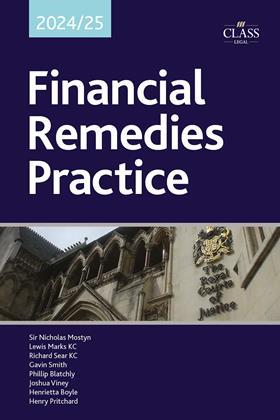Financial Remedies Practice 2024/25
Sir Nicholas Mostyn, Lewis Marks KC, Richard Sear KC, Gavin Smith, Phillip Blatchly, Joshua Viney, Henrietta Boyle and Henry Pritchard
£130, Class Legal
★★★★★
Now in its 13th edition, Financial Remedies Practice is established as one of the cornerstone procedural guides for family law practitioners. The book deals only with the application of the Family Procedure Rules (FPR) in practice and therefore covers only court procedure, rather than, say, the application of section 25 of the Matrimonial Causes Act 1973.
Financial Remedies Practice is clearly laid out. Each chapter contains the entirety of each part of the FPR and the accompanying practice directions, followed by a detailed commentary. As the rules and practice directions are freely available online, it is the commentary which is the book’s key selling point.

Since the latest iteration was introduced in 2010, the FPR have been updated on a regular basis. The unfortunate impact of a book of this nature is that it will be out of date the moment it is published. The changes during 2024 have, however, been relatively minor compared with previous years and therefore the book stands as a helpful procedural guide. It does not, however, include the new pre-action protocol which applies to all financial remedy cases commenced after 5 April 2024, but this is addressed in the preface.
Part 9 of the FPR 2010 deals with substantive financial remedy applications. The commentary on part 9 is a useful example of the user-friendly practical guidance in the book. For example, pre-first appointment steps are now not only addressed in the FPR, but also the 2022 Financial Remedies Court efficiency statement and primary principles. Clear step-by-step guidance of the pre-first appointment procedure is addressed in the commentary.
The approach to costs in financial remedy proceedings has been addressed in many recently reported cases. Although part 28 of the FPR, which deals with costs, runs to little over three pages in the book, the narrative runs to over 50 pages. This is a clear example of the usefulness of the commentary and the extent to which the rules themselves only provide basic guidance; they cannot be read without an analysis of the accompanying case law.
As acknowledged in the preface, the 13th edition is the last in which Sir Nicholas Mostyn provides a commentary on his final cases. Although he will remain an editor-in-chief, his contributions will be sorely missed.
Andrew Newbury is a partner at Hall Brown Family Law, Mancheste































No comments yet